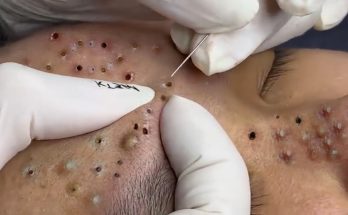The science on deep blackheads and how to banish them for good
Blackheads. Those pesky black dots that pop up on your nose, chin, cheek, or anywhere really.
These stubborn skin nuisances always seem to pop up, even on your best skin days. Despite knowing how common they are, blackheads have a way of stealing your confidence and can be really challenging to get rid of, too.
Want to learn how to banish blackheads for good? Discover the causes behind blackheads as well as best practice tips and tricks about how you should (and shouldn’t) get rid of them.
Ready to say goodbye to blackheads for good? Let’s dive in.
What causes deep blackheads?
Deep blackheads are a type of acne vulgaris, which is caused by dead skin cells, excess sebum, and dirt being trapped within clogged pores [1].
They most commonly occur on the face, neck, back, and chest, and that’s because most people typically have an increased number of sebaceous glands in these areas [2].

There are many different reasons why you could develop blackheads. You might have genetically oilier skin, excess dead skin cells or it could even be down to the medications you’re taking.
Hormonal fluctuations may also be at play here, with studies suggesting that when you’re navigating puberty, menstruating, pregnant or in menopause, you’re more likely to get blackheads, because that’s when your hormones fluctuate the most [3].
Why are my blackheads so deep?
Deep blackheads are caused by blackheads sitting underneath the skin for months or sometimes even longer [4]. It’s not uncommon to have a deep blackhead for years if you don’t find the right extraction method.
But why are blackheads more prone to being deeply embedded in the skin? Unlike whiteheads that protrude out from the skin, blackheads are open comedones (those bumps that you get from pimples) that sit underneath your skin [5].
When you got those pesky blackheads, it’s because your pores have gotten clogged up with sebum. And here’s the thing: there’s a chemical reaction happening under your skin with that sebum. It causes the clogged pores to turn black as the melanin in your skin’s pores is oxidising.
Should you squeeze deep blackheads?
We get it: it can be super tempting to pop blackheads, but there’s a handful of reasons you should resist, and they’re pretty compelling.
Scarring and inflammation can occur from squeezing deep blackheads (and these scars can last a lifetime on your skin). Squeezing is actually a type of skin trauma that leaves a lasting imprint on your complexion. Think about it: your skin is delicate and your nails are tough, which means applying too much pressure can seriously damage your skin [6].
But that’s not the only reason why you should steer clear of squeezing your deep blackheads. The act of squeezing can introduce more oil and bacteria into your skin, causing the clogged pore to become even bigger.
And on top of that, you may not be able to remove the entire blackhead that easily, and this can cause the blackhead to actually go further into your skin, which can increase the appearance of enlarged pores, and can even be painful.
What happens if you leave a deep blackhead?
The thing about blackheads is that most of the time, you don’t want to leave them.
Other types of acne vulgaris (like whiteheads) are more likely to go away on their own. But that’s not the case for deep blackheads. While blackheads can go away on their own, it is pretty unlikely, especially with deep blackheads.
The longer you leave a blackhead, the more likely it is to get pushed down even deeper, making it even more challenging to remove.
There is also a risk of infection and inflammation if left untreated, as it’s possible for bacteria to enter the pore, particularly when it’s enlarged with a deep blackhead.
How to remove deep blackheads
Now you know just how important it is to remove blackheads, let’s have a look at some different ways to get oily skin under control and treat deep blackheads.
At-home treatments
There are some great at-home remedies that can help remove deep blackheads, such as finding an effective deep-pore cleansing face wash to remove dead skin cells. When looking for an at-home remedy or face wash, some key ingredients to look out for are salicylic acid and benzoyl peroxide.
Tea tree oil is also said to be an effective method of removing blackheads. But just remember to dilute it with carrier oil; otherwise, it might be more damaging to the skin [7].
Be careful: not all ingredients are built the same, and some of these can be harsh on the skin, so it’s best to source your topical treatments and cleansers from a reputable brand.
Topical retinoids can help to decrease blackheads and they also work by ramping up skin cell turnover, which can help prevent deep blackheads from occurring [8].
Software uses ingredients like retinoids in its personalised acne-fighting formula. Simply take our online consult, share your skin goals and an Australian practitioner will customise a formula just for you. From here, your skincare treatment will be compounded and shipped straight to your door.
At-home remedies to avoid
If you have a lot of blackheads on your nose, a common at-home treatment is pore strips, but these can be needlessly painful and can damage the delicate skin on your nose so best to steer clear of these.
You can also pick up an extractor tool from most chemists, but just like squeezing, the pressure might do more damage than good in the long run. We recommend avoiding this option.
Professional options
We already know how it’s important to try to unclog a blackhead before it gets too deep, but that’s the challenging part. So if you’re struggling to get to the root cause of your blackheads and find them getting deep into the skin too often, it might be time to see a professional.
Luckily, there are a host of professional options out there for you.
Chemical peels can help to remove deep blackheads through skin regeneration, but it’s important to note that skin irritation can occur but does usually clear within 7-14 days. The good news? You can expect to start seeing the results in as little as 3-5 days [9].
Microdermabrasion is another great option. This non-invasive procedure uses a device to exfoliate the skin’s outer layer, which helps to unclog pores and eliminate blackheads. It can also improve overall skin texture and appearance.
Another way to reduce blackheads is by getting laser therapy, which can be effective in reducing blackheads as they work to target the bacteria and oil production associated with blackheads.
How do you prevent blackheads?
Because treating blackheads can be so challenging, the best course of action is to prevent deep blackheads from occurring in the first place.
But we all know how hard it can be to prevent clogged pores. Whether it’s your skin type, your hormones, the medication you’re on, or even just touching your face too much, there are so many things that can work against you when trying to prevent acne vulgaris from happening.
Salicylic acid helps treat blackheads at the root by unclogging pores and washing away dirt, debris and acne-causing bacteria.
Software’s Salicylic Acid Foaming Wash harnesses a powerful formula that gently exfoliates and washes away any built-up dead skin cells. It will leave you feeling squeaky clean and well-moisturised. That’s a win-win!



